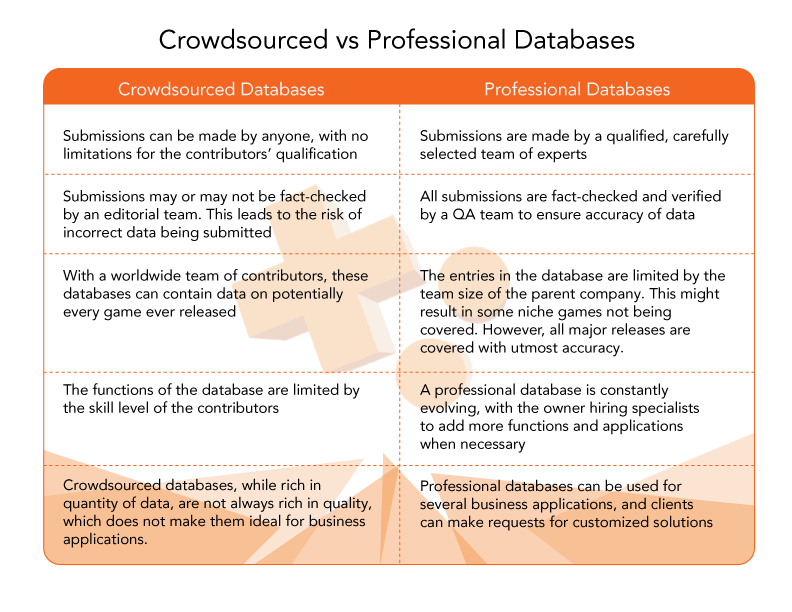Video Game Genre Trends Among Console Games In The Last Five Years
In 2020, the video game industry clocked global revenues of nearly $180 billion, up from almost $150 billion in 2019. It’s one of the fastest growing ecosystems in the world, especially considering the effect the pandemic has had on people, with more and more of them looking to video games for entertainment. The console market has a solid fifth of this pie, making it an essential segment to focus on. We at Gameopedia want to understand why gamers love what they play.
People with different tastes go for various types of games. For example, some people like games that test their reflexes, others like to solve puzzles, while some of them just want to unwind and build their fantasy world. These types of games are commonly categorized into genres. We have already published a detailed guide to learn more about the different kinds of Video Game Genres if you’re interested.
In this article, we will explore genre trends in the console market across the past five years, i.e. 2016-2020.
Consoles Covered
- PlayStation 4 – Launched in late 2013, the PlayStation 4 went on to sell more than 100 million units in its lifecycle, and served as the home for several bestselling games such as God of War, Horizon Zero Dawn, and The Last of Us Part II.
- PlayStation 5 – Launched in late 2020, in the thick of the pandemic, the PlayStation 5 provides a significant hardware upgrade over its predecessor.
- Xbox One – Launched in late 2013, the Xbox One started off weak against its rival, the PlayStation 4, and continued to lag behind in sales. It made up for this by providing support to older games through its backward compatibility feature, and later became known for its well-received Xbox Game Pass subscription.
- Xbox Series X|S – Launched in late 2020 alongside the PlayStation 5, the Xbox Series X is touted to be the “World’s Most Powerful Console”. The other member in the family – the Xbox Series S – carries the tag of being the “smallest Xbox ever made”.
- Nintendo 3DS – Launched in 2011, the 3DS was a popular handheld console whose USP was to display stereoscopic 3D effects without requiring the use of 3D glasses. The model had a long lifespan, getting discontinued in 2020.
- New Nintendo 3DS – Launched in 2014, this is a prominent revision to the original 3DS, bringing along with it several hardware enhancements. Curiously, it got discontinued a year earlier than the original 3DS.
- Nintendo Switch – Launched in 2017, the Nintendo Switch is a hybrid console that can switch between handheld and TV modes. This unique model quickly appealed to gamers worldwide, as the Switch shipped more than 14 million units in its first year.
As seen above, there are primarily three console brands, each with multiple devices available in the market during the study period. The newest entrants to the market – the PlayStation 5 and the Xbox Series X|S – arrived in November 2020, marking a new generation of consoles.
Put together, the games released for the above consoles represent a diverse mix, ranging from titles developed by a studio with hundreds of employees to a solo developer working tirelessly on their dream. They also represent a large mix of genres, catering to the varying tastes of the gaming market. When you want to analyze this data, Gameopedia’s expertise with game metadata and taxonomy come in handy.
Our Analysis of Video Game Genre Trends among Console Games
We utilized Gameopedia’s extensive database to build the dataset to be used for the study.
Since the focus of this study is on genre trends among console games, we built a list of games that were released on at least one of the above-mentioned platforms. Each game in our database is classified into one or more Genres. Further, we also took note of the game type, whose definitions are given below:
- AAA Games – These are games developed by large teams, backed by a huge budget, ensuring the production values are high. The scope of these games is similar to that of a blockbuster film. Only a handful of established studios across the world currently work on producing AAA games, and they are usually accompanied by a sizable marketing budget as well. Some examples of this type include Resident Evil Village, Returnal, and Ghost of Tsushima.
- AA Games – These games are developed by smaller teams as compared to AAA games, and have relatively smaller budgets and scale. Mid-sized and Major publishers are both known to develop AA games on occasion. Some examples of this type include A Plague Tale: Innocence, The Outer Worlds, and It Takes Two.
- Indie Games – While the word “Indie” stands for Independent, “indie game” is a term often used to describe games that have been built by extremely small teams (sometimes even consisting of a solo developer), with a minuscule budget compared to the other two game types. A smaller scale does not mean a smaller game however, and indie games are well-known to be creative and innovative. Some popular indie games include Gone Home, Untitled Goose Game, and Stardew Valley.
After building our dataset, we analyzed the number of releases across genres observed over the past five years. We also took note of the number of releases across each game type and looked for patterns.
Since the goal of this study is to examine trends among primary genres, we have excluded sub-genres from our dataset. Before going further into the study, it is important to explain how we define a ‘genre’ and ‘sub-genre’.
Simply put, any genre that isn’t a defining characteristic of the game is treated as a sub-genre. For example, an adventure game might contain a few levels where the player is required to solve simple puzzles to progress. However, solving puzzles isn’t the defining characteristic of the game. Players do not buy that specific game with the intent to solve puzzles. In this case, Puzzle becomes the game’s sub-genre, indicating that the game has a few puzzles, but they aren’t the main focus of the game. A game can have multiple genres and sub-genres.
Our Game Insights
Overall Genre Distribution from 2016-2020
AA Genre Trends
This graph showcases the major variations in genre trends across the last five years related to AA games.
AAA Genre Trends
This graph showcases the major variations in genre trends across the last five years related to AAA games.
Indie Genre Trends
This graph showcases the major variations in genre trends across the last five years related to Indie games.
It is immediately apparent from the study that two genres feature consistently at the top every year – Action and Adventure. This is true for each game type and each year. Some of the popular games belonging to these two genres over the past five years include Uncharted 4: A Thief’s End (Action, Adventure), Red Dead Redemption 2 (Adventure), Super Mario Odyssey (Action, Adventure, Platform), Call of Duty: Black Ops Cold War (Action, Shooter), and Battlefield 1 (Action, Shooter).
Action and adventure games have been and will always be extremely popular amidst gamers because they bring to the table the two best things about gaming: escapism and involvement. As the protagonist of these games, you usually have a great deal of power as well as choose how to use it to change the world(s) you’re in. With the advancement of technology, the setting of the game as well as the abilities your character has are only getting more and more awesome, so these genres will always be popular.
Action games aren’t necessarily violent all the time. Super Mario Odyssey, Nintendo.
Following the top two are a few genres that jostle for third place with varying results across the game types and over the years. One genre that keeps cropping up here is the Shooter genre.
Shooter games are arguably one of the most popular kinds of game, no matter how you define popularity. Are we talking sales? The annual Call of Duty games consistently feature among the bestselling games each year. Are we talking about actual playtime? Some of the most played games in the world are shooters – Counter Strike: Global Offensive, Fortnite, and PUBG: Battlegrounds, to name just a few. And yes, even in our own study, we noticed that across all game types, the Shooter genre did feature in the top 3 in every year except one. Nothing quite gets one’s adrenaline pumping like a high intensity firefight. As newer shooter games come out, the social aspect related to these games is under constant enhancement as well with an increased focus on tactics, team coordination, and communication. This keeps the genre ever-beloved, be it single-player or multiplayer titles.
Next up is the puzzle genre, which is among the most beloved genres in the market, although this is not immediately visible. Games like The Witness (Adventure, Puzzle) and Tetris Effect (Action, Puzzle) may not receive as much publicity as a highly-marketed AAA game like Cyberpunk 2077 (Adventure, Role-Playing). However, they are well-received by the market and have a dedicated audience.
Puzzle games are a good way to unwind at the end of the day. Tetris Effect, Enhance Games.
It is no wonder then, that indie games feature the most amount of releases for the Puzzle genre, where it consistently features in the top 3 or top 5 at worst. It features among the top 10 for AA games, while it is entirely absent from the top 10 list for AAA games. This makes a lot of sense because compared to action, adventure, or even shooter games, puzzle games don’t need to be as graphics-intensive or have a complex setting. They’re more about gameplay and engaging their audience, and thus, easier for smaller studios to make.
Another genre that has proven to be consistently, quietly popular are Role-Playing games. This is a genre that never quite reached the top in terms of number of releases, but makes its presence felt nonetheless. Among AAA games, Role-playing games featured among the top 3 most-released genres for every year, while it did so for four straight years for AA games, losing out the third place in 2020.
Nothing beats exploring an alien world on a Saturday night. The Outer Worlds, Take-Two.
Curiously, a lot of indie publishers seemed to avoid releasing Role-Playing games, as the genre always made up less than 5% of all indie game releases in any year. This explains why some of the most well-received Role-Playing Games of the past five years are all AA/AAA titles. Some of these include Final Fantasy VII Remake (Role-Playing), The Outer Worlds (Role-Playing, Adventure), and Assassin’s Creed Odyssey (Role-Playing, Adventure). It makes sense if you think about it: the most popular RPGs are those with beautiful, rich, detailed worlds and elegant gameplay mechanics, which might be hard for indie gamemakers to create when compared to AA/AAA studios.
Similar to Role-Playing games, indie publishers didn’t release a lot of games in the Sports genre in the past five years. These games however have been consistently popular with AA/AAA publishers. It is easy to point out that there are a few annual sport franchises – FIFA, NBA 2K, Madden NFL, NHL – which make up for the bulk of sales and media attention each year. However, this study takes into account the number of game releases each year, and the above-mentioned franchises are but a tiny percent of the overall pie.
What comes to mind is how most of these games facilitate online gameplay with players around the world. Competition is a key feature of these games; whether you’re playing against your buddies for fun or taking part in a high-stakes tournament, you’ll end up enjoying yourself. The real-world element that a lot of sports games provide as well, with references to actual athletes and teams help it to stand out and have a dedicated group of consumers. This genre provides a very unique experience which accounts for its consistent popularity.
Riding down dangerous curves. MotoGP 20, Milestone.
Among AA games, the genre features among the top 10 consistently, with 2020 being its best year, where it broke into the top 3. This year saw the release of such games as Rugby 20 (Sports), MotoGP 20 (Sports, Racing, Simulation) and Football Manager 2021 (Sports, Simulation, Strategy). Now let us turn our attention to a genre that is popular with indie game publishers, and not so much with the AA/AAA publishers.
Looks simple, but isn’t. Celeste, Matt Makes Games.
The Platform genre is one of the oldest genres in the industry. Classic games such as Donkey Kong (Action, Platform) and Super Mario Bros (Action, Platform) were pioneers of the Platform genre, and it was popular with AAA publishers for a long time. Franchises such as Prince of Persia, Tomb Raider and Uncharted made their name by being excellent platforming games. However, of late, the genre is fast disappearing from AA/AAA titles, and has found a new home among the indie scene.
The numbers indicate that the genre either features at the very bottom of the list or doesn’t make the top 10 list at all for AA/AAA released in the past five years. For indie games however, it always features in the top 5, with the total percent of releases falling between 9 – 12% each year. Some popular platform games released recently include Super Meat Boy Forever (Platform, Action), New Super Lucky’s Tale, (Platform, Adventure, Action) and Celeste (Action, Platform). This is an interesting trend: if you look at these games, they’re intuitive, easy to understand while challenging to master, and have very unique art styles. While they aren’t always as technically groundbreaking as releases from bigger publishers tend to be, they nevertheless satisfy the most important rule of game-making: they’re fun!
Conclusion
Just like any other market, the stakeholders in the video game industry are constantly aware of changing trends and try to appeal to their consumers. While it’s safe to say that games featuring a combination of the Action, Adventure, and Shooter genres will continue being a safe bet for now, the market is wide open for a broad mixture of genres to be explored.
The fact that the same genres do not appear among the most released games every single year is a strong indicator of a market that is eager to try something new, while still having something familiar to return to at the end of the day.
No matter what combination of genres game publishers come up with over the next five years, you can be assured that we at Gameopedia will always be here. We’re ready to guide you through the exciting world of video games with our game comparison and sentiment analysis tools, as well as other interesting projects we have in the works. Drop us a line if we can help you with anything!







